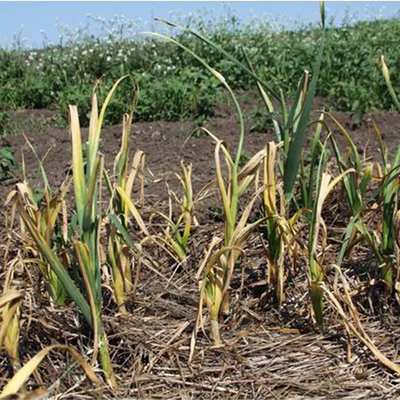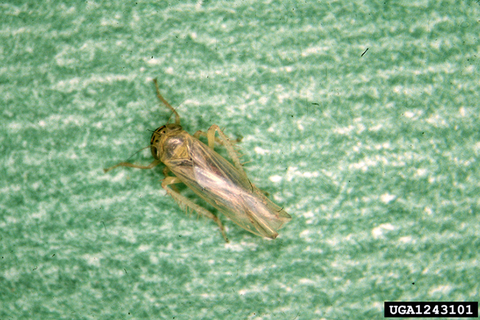Quick facts
- Aster yellows is a plant disease that can infect many plants.
- Infected plants have yellow leaves and stems, stunted growth and small malformed flowers.
- The aster leafhopper can carry the aster yellows pathogen. Plants become infected when fed on by leafhoppers carrying the pathogen.
- Once infected with aster yellows, a plant will never recover.
- Plants infected with aster yellows should be removed from growing areas and destroyed.
Aster yellows symptoms
- Plants infected early in the growing season may remain small and stunted.
- Leaves are discolored from pale green to yellow or white. In some plants, red to purple discoloration of leaves occurs.
- Leaves may be small and stunted.
- Many thin, weak stems grow close together forming a witches' broom.
- Flowers are small, malformed, and often remain green or fail to develop the proper color.
- Taproots of carrots are thin, small, covered in many root hairs, and often taste bitter.
Damage to garlic
Aster yellows has caused a lot of damage to Minnesota garlic. Symptoms in garlic include:
- Premature yellowing and dieback of garlic plants.
- Small, often soft bulbs.
- Dark streaking or discoloration of the wrapper.
- Unusual smell to the bulb.
- Very poor emergence of infected seed.
How to identify aster leafhoppers
Aster yellows is spread by an insect called aster leafhopper. This insect is hard to differentiate from other species of leafhoppers.
- Aster leafhoppers are small and quick moving.
- Adults are wedge-shaped.
- Their color is from brown to yellow to green.
Biology
- Aster yellows is caused by a phytoplasma (small bacterium).
- The pathogen can live only within the vascular system of a plant or within the leafhopper that brings it from plant to plant.
- The aster yellows phytoplasma moves systemically through the plant, infecting every part from the roots through the flowers. The pathogen affects the plant’s growth, development and ability to store nutrients.
- The aster yellows phytoplasma will not survive in the debris of infected plants but can survive in the crown and roots of infected perennial plants.
Aster leafhoppers move the phytoplasma from infected plants to new plants.
- When adult and nymph aster leafhoppers feed on plants infected with aster yellows, they ingest some of the phytoplasma along with the plant sap.
- In a minimum of two weeks, the phytoplasma moves through the insect's gut into the salivary glands.
- At this point, when the leafhopper feeds, a small amount of phytoplasma is released into the plant. This starts a new infection.
- The leafhopper will transmit the pathogen every time it feeds for the rest of its life.
Aster leafhoppers are insects that migrate into Minnesota each season.
- The majority of the aster leafhopper population overwinters in southern states, feeding on grain crops and other plants. Only a few aster leafhoppers overwinter in Minnesota as eggs.
- Weather systems carry the insects north early in the growing season.
- Only a small number of these leafhoppers carry the aster yellows phytoplasma.
Managing aster yellows and aster leafhopper in home gardens
We cannot cure plants that have been infected with aster yellows. Instead, focus on removing plants showing aster yellows symptoms and making your space less attractive to aster leafhoppers.
Resistant varieties
- For some plants, there are aster-yellows-resistant varieties available.
Cultural controls
- Completely remove infected plants from the garden. Once a plant is infected with aster yellows, there is no way to cure it. This can be difficult but is a necessary step to saving other susceptible plants from becoming infected.
- Remove all perennial weeds from your landscape. If infected with aster yellows, the disease will survive in weeds from one season to the next.
- Do not use cloves from aster yellows infected garlic as seed. At this time, there are no known garlic varieties resistant to aster yellows.
Because aster yellows does not survive in dead plant tissue, there are a couple of disposal options for infected plants.
- Bury it in your home compost pile or in the ground. Make sure it is completely covered so insects cannot feed on the infected plant materials. Aster yellows will not survive once the plant is dead.
- Burn it. Check fire restrictions in your area prior to burning.
- Note: It is against the law in Minnesota to put any plant materials in residential garbage.
Using pesticides
Because leafhoppers are quick-moving and sturdy, it is hard to effectively manage them with insecticides. There are few effective potential products available to home gardeners.
Managing aster yellows and aster leafhopper on farms
Monitoring for aster leafhopper
Leafhoppers are quick-moving, which makes estimating their population difficult. Estimating their populations through traditional scouting will not give a good estimate of populations.
Sweep nets are the best way to estimate the size of aster leafhopper populations.
- Use a 15-inch diameter sweep net in a 180-degree arc through the top six to eight inches of the crop 20 times in five different locations in the field (100 sweeps) and count the aster leafhoppers captured.
- Aster yellows susceptible carrot varieties have a threshold of 20 aster leafhoppers per 100 sweeps.
- There are no thresholds available for garlic or other crops.
Weather and activity on neighboring fields can also increase leafhopper populations.
- Leafhoppers can move into vegetable fields when neighboring wheat or alfalfa fields are harvested.
- Weather fronts from southern states can carry leafhoppers north.
- Dry conditions can draw leafhoppers to irrigated vegetables.
If you suspect a plant has aster yellows, the only way to confirm this is with a diagnosis from a lab. You can send plants to the Plant Diagnostic Clinic for confirmation.
Resistant varieties
- In carrots, there are varietal differences in aster yellows tolerance.
Cultural controls
- Once aster yellows infects a plant, there is no way to cure it.
- Remove infected plants.
- Control perennial weeds. If infected by the aster yellows phytoplasma, these plants allow the pathogen to survive in the field from one year to the next.
- Do not use cloves from aster yellows infected garlic as seed. At this time it is unknown if there are any garlic varieties resistant to aster yellows.
- Light-colored or reflective mulches will disorient aster leafhoppers and can reduce feeding on the crop. Light reflected off the plastic covering of low tunnels or high tunnels will affect leafhoppers in the same way. These structures will have some protection from aster yellows infection of crops.
- Covering the crop with floating row covers for the entire season will prevent leafhoppers from reaching the crop and transmitting the disease. This strategy may be useful to protect a seed crop.
Chemical controls
Look for products labeled for leafhoppers in the crop you are producing. We cannot treat the disease, so applications focus on preventing leafhoppers from feeding on plants.
Use the Midwest Vegetable Production Guide for current recommendations. Some chance of infection remains even with insecticide applications.
Because of the lag between aster leafhopper feeding and a plant developing and displaying aster yellows symptoms, aster leafhopper treatment can stop two to three weeks before harvest.
CAUTION: Mention of a pesticide or use of a pesticide label is for educational purposes only. Always follow the pesticide label directions attached to the pesticide container you are using. Be sure that the plant you wish to treat is listed on the label of the pesticide you intend to use. And observe the number of days between pesticide application and when you can harvest your crop. Remember, the label is the law.
- Midwest Vegetable Production Guide. Purdue University.
- Vegetable Disease ID and Management. Cornell University. 2003.
- "Vegetable Insect Management with Emphasis on the Midwest," Ch.15. Meister Publishing Co. Willoughby, Ohio.
Reviewed in 2023



